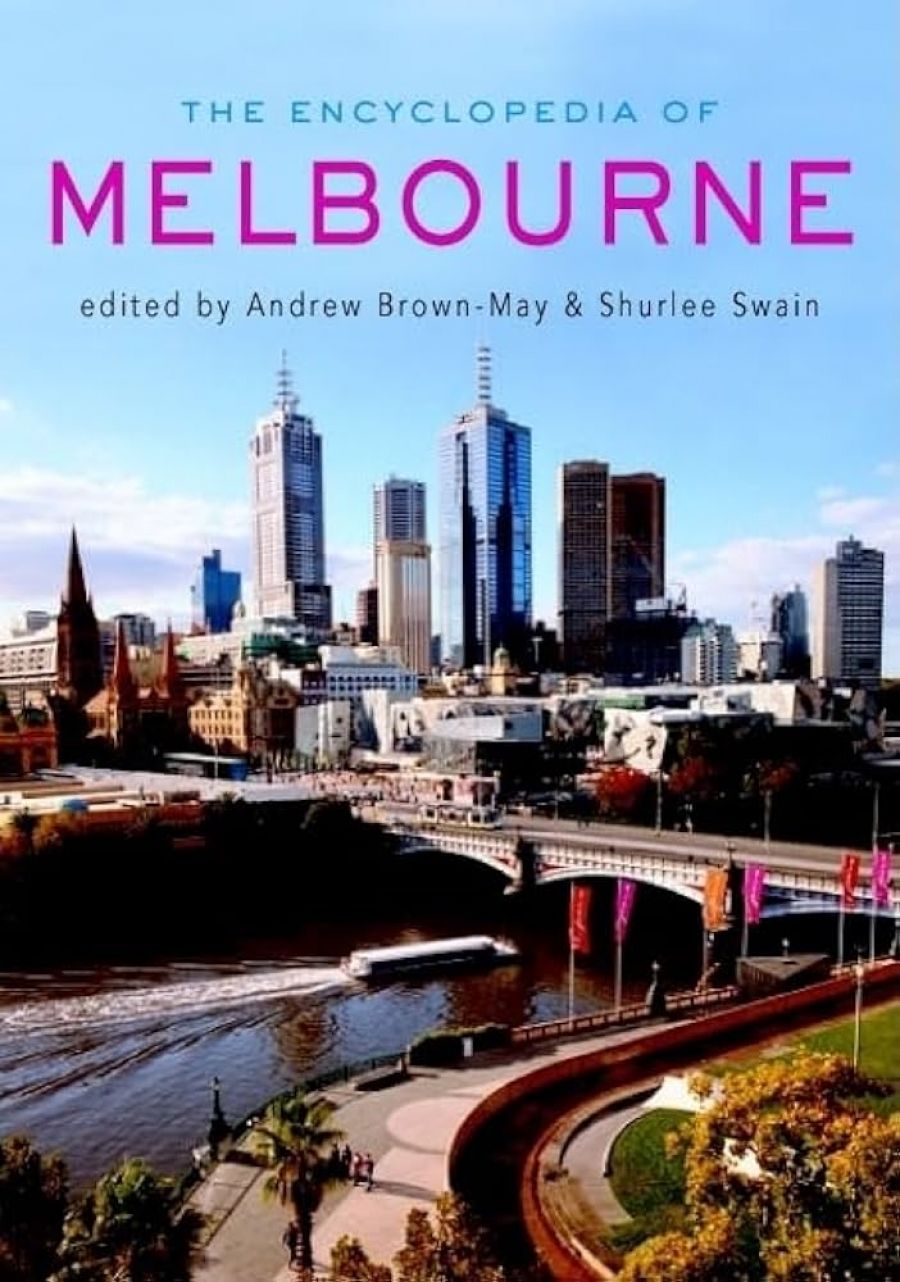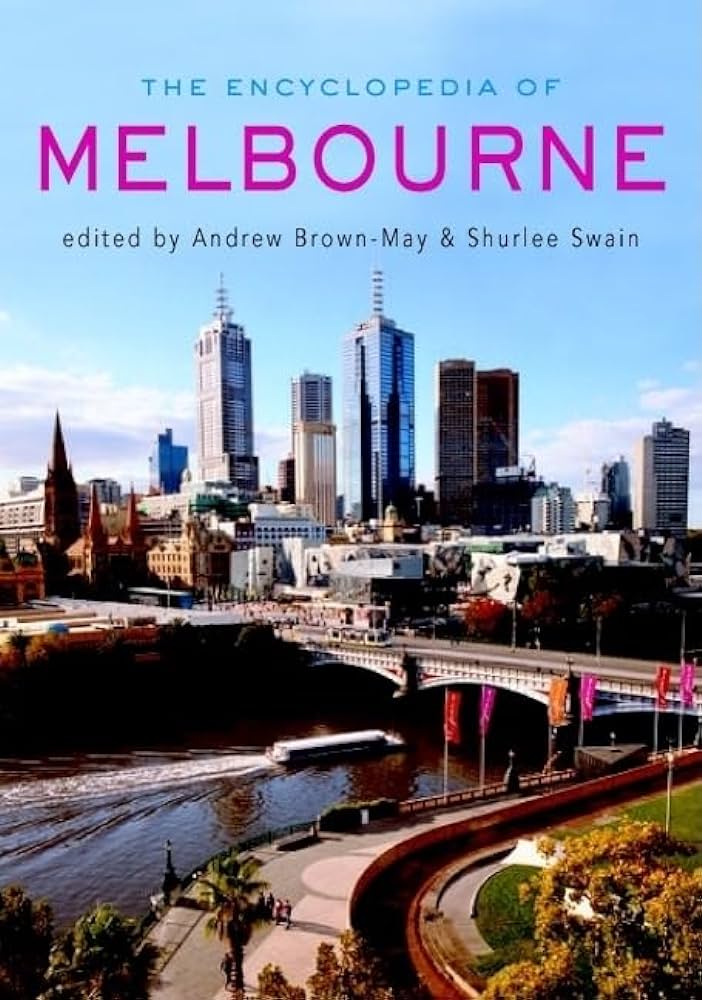
- Free Article: No
- Contents Category: Australian History
- Review Article: Yes
- Article Title: Before Starbucks
- Online Only: No
- Custom Highlight Text:
This Encyclopedia – claimed by the publishers to be the first for Melbourne – is an immense undertaking. The sheer numbers are staggering: 1500-odd articles, 850,000 words, 250 illustrations, nineteen maps and twenty-one tables, produced over a period of nearly ten years by an army comprising two principal editors, five associate editors, fifteen working parties and 440 authors (to say nothing of administrative and publishing staff). Fourteen notable residents offer more reflective pieces on ‘My Melbourne’, ranging from Stephanie Alexander on ‘Eating Melbourne’ and Barry Dickins on St Paul’s Cathedral (his ‘favourite place of anarchy’), to Barry Humphries’ elegiac meditation on ‘the days of Gladstone bags and gloves and hats and glads, / Before Melbourne had been Starbucked, and the trams plastered with ads’.
- Book 1 Title: Encyclopedia of Melbourne
- Book 1 Biblio: CUP, $150 hb, 822 pp, 0521842344
- Book 1 Cover Small (400 x 600):

- Book 1 Cover (800 x 1200):

Members of the editorial team are responsible for about one-third of the articles, working largely in their areas of academic specialisation. Andrew Brown-May has concentrated on the city and inner suburbs (Flinders Lane, Georges department store, hawkers, horses, coffee); Shurlee Swain on social welfare (ladies’ benevolent societies, domestic service, infant welfare); John Lack has a near-monopoly on the western suburbs; and Graeme Davison’s articles include motor cars, freeways, road safety and marvellous Melbourne.
In other areas, the usual suspects have the lions’ shares (though not necessarily monopolies): Lurline Stuart on newspapers and periodicals; Paul de Serville on clubs; Mimi Colligan and Frank van Straten on theatres and popular entertainment; Miles Lewis on aspects of building and design; A.G.L. Shaw on aspects of foundation and early history. Those institutions and localities not covered by the authors of published histories have been picked up by members of the editorial team and (for smaller localities, especially) by Jill Barnard and Jenny Keating, of Monash University. Contributors are overwhelmingly Melburnians but include a few outsiders such as James Jupp on English (the people, not the language) and Kate Burridge on language.
Cross-references within articles are indicated in bold type. This usually works well, though the system occasionally fails: the articles on literary criticism and literature both have references to the separate article on Meanjin but fail to indicate that there is also an article on Overland. Convenience stores has a cross-reference to milk bars, but not vice versa. And occasionally the cross-referencing gets absurdly out of hand, as in the article on Post Offices:
From landmark buildings in local shopping strips to humbler agencies in smaller settlements, post offices served as bases for telegram boys and ‘posties’, who, astride department-issue bicycles, dodged suburban dogs … The postmaster, like the bank manager, was a pillar of the local community …
There is a lingering suspicion that this cross-referencing was computer-generated.
The editors have been generous in their allocation of words. While some smaller localities and other minor subjects rate only fifty or one hundred words, the major political parties each have about 1200, climate has 3200 (as well as three graphs, two pages of tables, one illustration and twenty-five cross-references) and literature has about 5000 (with a further 650 on crime fiction, as well as many articles on related and more specific aspects of literary culture). Theatre has about 3500, classical music about 1000 and jazz 800 – again, with numerous related articles on venues and companies.
Most articles have, if appropriate, one or two suggestions for additional reading. But there are occasional lapses. It’s a surprise, for example, to find no references for Collingwood Football Club (on which there must be at least a dozen books) or the Australian Labor Party.
There are two major, and related, problems in the conception and execution of the Encyclopedia. The first is the decision to exclude biographical articles, based on the argument that ‘any limited selection of worthies would have simply duplicated the comprehensive Australian Dictionary of Biography’. Excellent as the ADB is, it is not comprehensive; and it includes no one who died after 1980. It might be a misunderstanding of the editors’ policy on biography, or simply the preferences of individual authors, that has led to some wild imbalances in the use of personal names within articles. Melbourne Boys’ High School, for example, has none, while Scotch College names four principals and sixteen eminent old boys.
The second problem is with the index. Still on the biographical problem, the editors’ policy has been to index personal names only if they appear in two or more articles. So only eight of those twenty Scotch College names are indexed. But there are many other problems with the index. There are two index references to the Melbourne Advertiser (Melbourne’s first newspaper), but no pointer to the major reference in newspapers and periodicals. The article on Kinnear’s Rope Works is indexed under that name, but not under ‘rope’. Some of the indexing and arrangement of personal names is very odd. Sir Dallas Brooks (governor, Freemason and attender of the opening concert at the Sidney Myer Music Bowl) is entered under ‘Dallas’. Within the numerous Clarkes, ‘Lady Janet’ and ‘Sir Andrew’ are filed under ‘Lady’ and ‘Sir’ rather than ‘Janet’ and ‘Andrew’.
No print-based reference work can hope to be absolutely current. There is remarkably little evidence, however, that this book has been in the making for ten years. Chris McConville’s surveys of crime and organised crime, for example, are admirably comprehensive, missing only the most recent events in the city’s murky and complex underworld. A few articles, though, lack chronological balance, either dwelling too much on the past or emphasising the present and the recent past at the expense of a more considered historical view.
The perceptive reader who spots gaps in the Encyclopedia can suggest additional subjects for the proposed ‘interactive gateway … with the potential to be updated’. My own list would include bread and bakeries (though dairying and milk supply is in), Christian Science, the Ford Motor Company (which rates several mentions but, unlike General Motors-Holden, lacks its own article), green belts, the Melbourne Times, motels, Playbox Theatre Company (which is hidden in the article on the Malthouse Theatre, and is not indexed), Rechabites, Royal Tennis, rugby (both League and Union), Safety Beach, St Martin’s Theatre, urban sprawl and Western Port Bay. The risk is, of course, that making the suggestion will result in an invitation to contribute.
The Encyclopedia of Melbourne is unquestionably a major achievement – an almost unfailingly reliable and entertaining reference work and a wonderfully time-filling and surprising field for browsing. Useful though the ‘interactive gateway’ will undoubtedly be, this handsome volume deserves to be long-treasured and well-used.


Comments powered by CComment